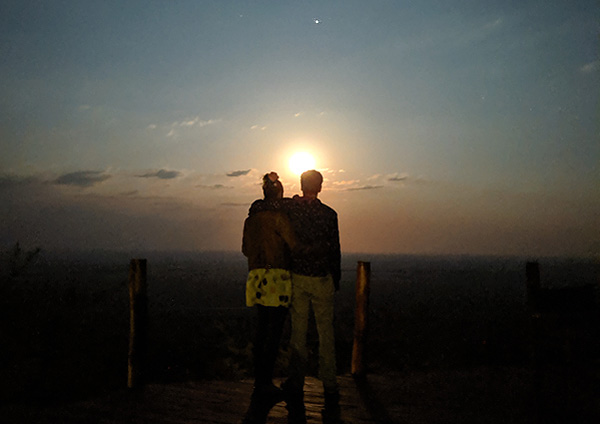 I was very worried. To begin with I don’t particularly like the dry season. The enormous amounts of dust kicked up by the rovers when traveling is constantly irritating, but more generally I just don’t like seeing the beautiful veld so dry and stressed.
I was very worried. To begin with I don’t particularly like the dry season. The enormous amounts of dust kicked up by the rovers when traveling is constantly irritating, but more generally I just don’t like seeing the beautiful veld so dry and stressed.
The silver lining is that the cats are in their heyday, picking off weakened animals like flies.
We saw so many lion on this safari I lost count. One pride of 17 included three beautiful and very healthy females, two younger females and three sets of 4-cubs each.
So far we’ve seen three leopard, including yesterday’s mega male who scared the bejesus out of me just looking at him. It didn’t help that moments after we turned off the car to watch him a 7-foot long black mamba scurried across the road in front of us.
The mamba is the most dangerous snake we have. We call it the seven step snake: After it bites something that something has only seven steps left in the living world.
All this makes an incredibly exciting safari. But I know what the dry season means. It means as the lion slowly harvest everything around them there will be less and less available and the 4- and 5-month old cubs start to starve.
The cruelty of the dry season is Africa’s arctic dark. It’s natural and inevitable, but climate change has made it worse: Now it’s unpredictable.
The basis of the entire Serengeti is the wildebeest. The millennial old migration of about 2 million animals redoing an ancient cycle of renewal prepares the veld for virtually every animal we have here, from the lion to the dung beetle.
For the majority of my career it was as predictable as the seasons. In normal times the animals moved more or less together in a grand oval bulging a bit westwards, clearing the savannah of its grass and preparing a dry season that was harsh but not cruel.
Now with more rain than ever that drops in thunderous little cones over small sections of the veld, unexpectedly beautiful grass grows months out of cycle, tempting portions of the great herd to stay behind or travel in the wrong direction.
We saw migrating wildebeest in the crater, the furthest south in the ecosystem, captured by good rain there and a Sahara-like desert just to their north. We watched long blarting files of zebra and wildebeest in the Moru Kopjes in the middle of the Serengeti, imprisoned on all sides by dust devils and hazed over landscapes reminiscent of the Sahara.
How these multitudes of animals will ever make it where they should be, I can’t imagine.
So it was such great relief yesterday as we moved north and saw more and more consistency in the veld, verdant landscapes and thousands and thousands of animals.
We set up lunch overlooking the Balaganjwe Plains where behind us I estimated around 35,000 wildebeest were eating the last of the green grass, lingering around the blackwater pools yet refreshed every few days by the last of the summer rains.
More than once we stopped in our tracks as a frantic migrating file of wilde raced across just in front of us, the beginning and end of the file lost in the hill horizons.
This far northern area of the Serengeti is almost identical to the Mara’s rolling grassland hills that stay green eleven months of the year. We took spectacular back tracks encountering no other cars almost all day long, but passing what I estimated were about 200,000 wilde and zebra.
These will – if nature and tradition prevail – move across the Mara river soon, out of Tanzania into Kenya just as they should do. And the beautiful lush green veld and acres and acres of waving oat grass under distant thunder heads, lightning sparking in the distance will slowly, methodically quiet down.
The sky will clear, the wind will die, the temperatures will slowly warm. The wilde will thunder over the veld, crashing across the turbulent Mara River into Kenya where the rain continues and new grass grows until October while the endless oat grass fields of the Serengeti wilt and die, dropping billions of the next season’s seeds onto the hardening earth.
That’s as it should be and how those of us who love this place have come to accept.
Until climate change wields a cleaver in its path, and thousands of animals grow confused, and the moon flower blooms twice and the baobab leaf out of season and thousands of wilde get captured in little deserts earth never intended be made. What will come of such mayhem?